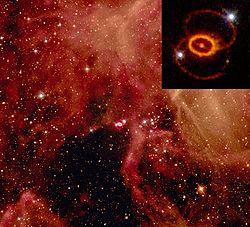Sanduleak -69 202
| Observation data Epoch J2000 Equinox J2000 | |
|---|---|
| Constellation | Dorado |
| Right ascension | 05h 35m 27.92s[1] |
| Declination | −69° 16′ 11.1″[1] |
| Characteristics | |
| Spectral type | B3 Ia[2] |
| Details | |
| Mass | ~20[2] M☉ |
| Radius | 39.6[citation needed] R☉ |
| Luminosity | ~100,000[2] L☉ |
| Temperature | 16,000[2] K |
| Other designations | |
Sk -69 202, GSC 09162-00821 | |
| Database references | |
| SIMBAD | data |
Sanduleak -69 202 (Sk -69 202, also known as supernova 1987A.
The star was originally charted by the
Romanian-American astronomer Nicholas Sanduleak in 1970, but remained just a number in a catalogue until identified as the star that exploded in the first naked eye supernova since the invention of the telescope,[1] when its maximum reached visual magnitude +2.8.[3]
The discovery that a blue supergiant was a supernova progenitor contradicted all known theories at the time and produced a flurry of new ideas about how such a thing might happen,[4] but it is now accepted that blue supergiants are a normal progenitor for some supernovae.[5]
The candidate luminous blue variable HD 168625 possesses a bipolar nebula that is a close twin of that around Sk -69 202. It is speculated that Sk -69 202 may have been a luminous blue variable in the recent past, although it was apparently a normal luminous supergiant at the time it exploded.[2]
See also
References
- ^ Bibcode:1970CoTol..89.....S.
- ^ S2CID 17598600.
- ^ "SN 1987A". The International Variable Star Index. AAVSO – American Association of Variable Star Observers. Retrieved August 19, 2019.
- doi:10.1086/133043.
- S2CID 1660838.

